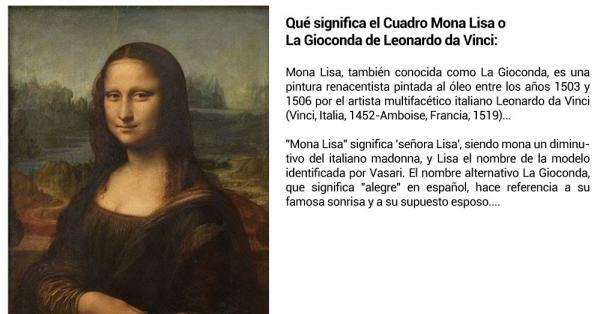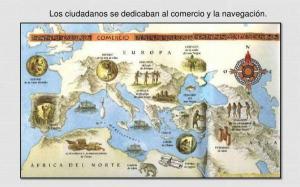The GIOCONDA by Leonardo Da Vinci

La Gioconda or Mona Lisa by Leonardo Da Vinci It is one of the most enigmatic, rich and controversial works of Art History. The speculations about the identity of the model, what is behind his enigmatic smile, how long Leonardo worked on this work, why he kept it with him and how it became part of the French royal collection are questions that have led many researchers to delve into the work and set out in search of answers.
In this lesson from unPROFESOR.com we offer you the commentary and analysis of the Mona Lisa by Leonardo Da Vinci, an iconic and majestic work that constitutes one of the most famous and fascinating paintings in history.
Index
- What does the Mona Lisa represent? Comment from La Gioconda
- Iconographic analysis of La Gioconda
- Curiosities of the Mona Lisa - Analysis of the Mona Lisa
- Composition of La Gioconda
What does the Mona Lisa represent? Comment from La Gioconda.
The Mona Lisa it's a renaissance oil(Cinquecento) work of
Leonardo da Vinci, one of the great Renaissance artists and genius of art and science. The work is located in the Louvre Museum in Paris (France).Leonardo Da Vinci painted this picture between the years 1503 and 1505, leaving us in him a new way of conceiving painting. Thus, the Mona Lisa is the first Italian portrait in which a model is painted in a half-length portrait, that is, including the arms and hands, in addition to doing it on a realistic scale.
The figure appears seated on a chair and with a landscape in the background, being a formula that influenced Florentine and Lombard art from the beginning of the 16th century and that connects with the three-quarter figure views of the landscape, architectural environment and joined hands typical of the Flemish portrait of the second half of the century XV. The novel aspects added by Leonardo are the technique of "Sfumato"or atmospheric illusionism, monumentality and balance that give the figure an unreal and enigmatic appearance.
Mona Lisa Themes
La Gioconda has always been admired for its enigmatic smile, her serene beauty and her fascinating gaze, without knowing with complete certainty who the represented woman is. One of the latest theories considers that Leonardo painted her mother or an idealized image of her on it.
A kind of secular virgin in which Leonardo captures that ideal woman or mother, This being perhaps the reason why he never considered that the painting was finished, nor did he give it to whoever was supposed to commission it, to Francesco del Giocondo.

Image: La Vuelta Stationery
Iconographic analysis of La Gioconda.
We continue this analysis of The Mona Lisa to speak, now, of the iconography of this important work of Leonardo Da Vinci.
Lisa Gherardini, The Mona Lisa
As we have already noted, critics disagree on the model identity. Thus, it has been ventured that she could be a young woman dressed as a woman, one of Giuliano de Medici's lovers and even a portrait of Leonardo himself as a woman.
However, the most accepted theory, and collected by the art historian Giorgio vasari (1550), is that it was Lisa Gherardini, Mona Lisa, the wife of the wealthy Florentine cloth merchant Francesco del Giocondo. Leonardo kept the work and, on his death in 1519, it became the property of King Francis I of France.
The author
Leonardo Da Vinci (1452-1519) he was the illegitimate son of a wealthy Florentine notary and a young peasant girl. Since I was a child I have been an apprentice in the workshop of Andrea Verrocchio, sculptor and painter, and became one of the great geniuses of history for the mastery he achieved in painting, architecture, sculpture, engineering, biology, music and literature. A universal man, Leonardo achieved great fame already in his time working for nobles, popes and kings.
At the moment in which Leonardo paints La Gioconda, the Cinquecento, is the moment in which new artistic centers such as Venice emerge, the Counter-Reformation appears and Leonardo, Michelangelo and Raphael They are the great figures of art.

Curiosities of the Mona Lisa - Analysis of the Mona Lisa.
One of the most striking elements of The Mona Lisa is his face, especially his mysterious look and his enigmatic smile. A face in which he draws the attention of eyelashes and eyebrows, the product of poor restoration, and a certain greenish tone, also a product of it. Some failures that did not detract from the appeal of a painting in which Leonardo seems to want to show us the happiness in the model's smile.
An idea of happiness to which the use of warm colors and the use of sfumato. Thus, Leonardo used this technique to blur the lips and eyes, in addition to the curls of the hair, hair that melts with the rocks of the landscape and the folds of the shawl.
With this technique, Leonardo managed to recreate the effects of light on the woman's skin and on the landscape, providing an almost unreal appearance and a softening of the face. For this, Leonardo chose a poplar wood support prepared with several layers of plaster. Once the panel was prepared, the painter first drew directly on it and later he was painting in oil with great patience and using very diluted colors. The ultimate goal was to apply different layers and for these overlays to give the face multiple effects of lights and shadows and a great naturalness.
The study carried out with a high resolution camera showed how Leonardo drew the portrait on paper and he transferred it to the canvas with a technique resembling tracing. There are also marks and alterations such as the change in the positions of the fingers of the left hand, as well as the use of more vivid colors than those that are preserved.
Another of the great discoveries of the test are the marks seen in the eyes of La Gioconda: a LV in her right eye, and that could be the initials of the painter, and the letters CE or CB, in the left eye. In addition, in the arch of one of her eyes you can see the number 72 in Roman numerals (LII).

Image: Slideshare
Composition of La Gioconda.
Although the composition is apparently simple, Leonardo manages to bring movement to the painting with a series of resources such as making the two sides of the painting not coincide exactly either in the landscape or in the face of the woman. A) Yes, the woman's expression is different depending on where the viewer is looking from and is located.
Likewise, the woman is also the point at which the gazes converge, especially her face, also being her hands another of the points on which attention is focused.
If you want to read more articles similar to The Mona Lisa by Leonardo Da Vinci - Commentary and analysis, we recommend that you enter our category of Story.
Bibliography
- VVAA (2019) Leonardo Da Vinci. Complete pictorial work. Taschen Benedikt
- Sassoon, Donald (2007). Mona Lisa. History of the most famous painting in the world. Review

